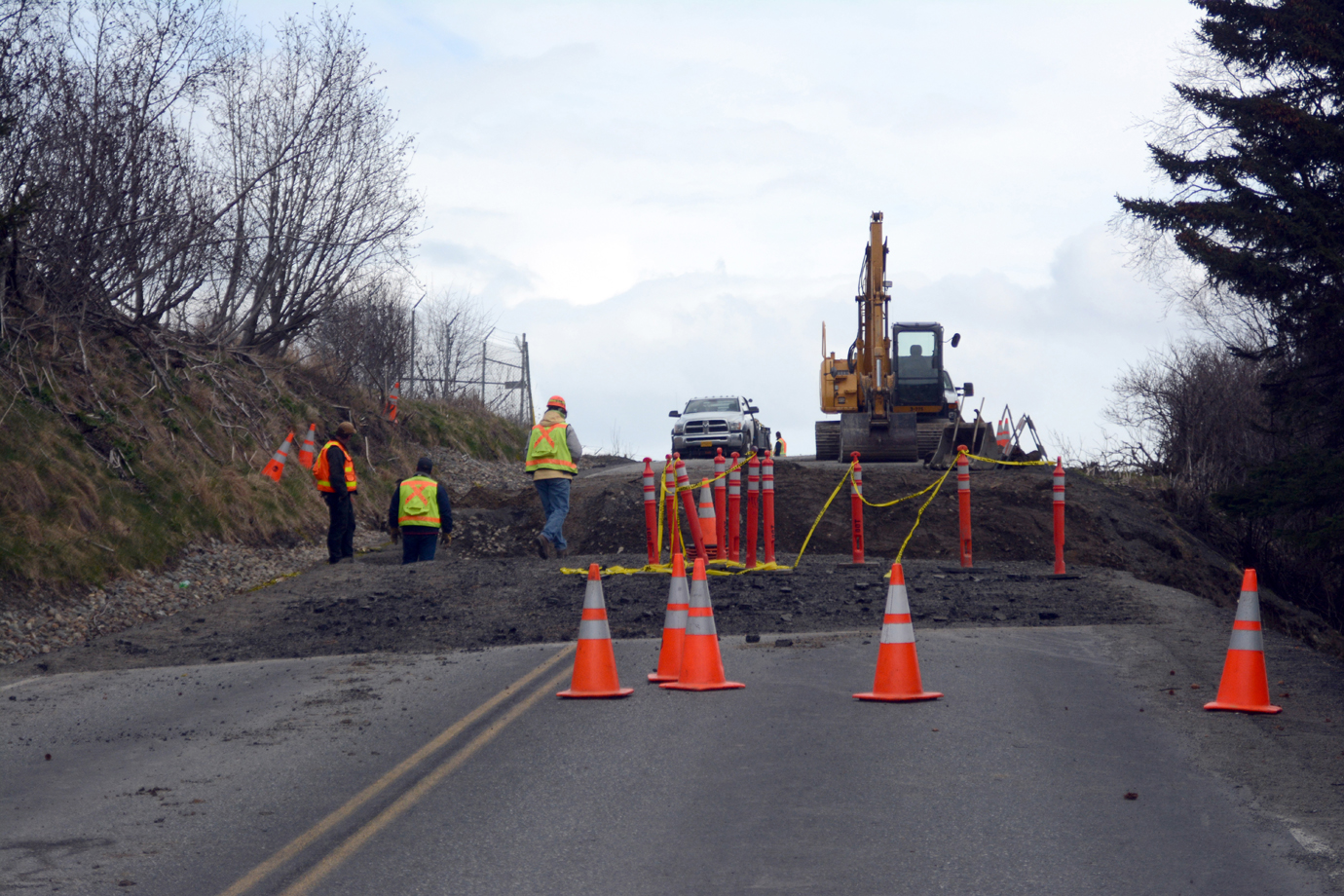Workers this week began digging out about a 70-foot wide collapsed section of the west end of Kachemak Drive and getting permits to repair a slide that shut down the road about a half-mile from its intersection with the Homer Spit Road. Repairs may take as long as two weeks, said Carl High, maintenance supervisor for the Alaska Department of Transportation and Public Facilities, Soldotna. Kachemak Drive is a state owned and maintained road.
Kachemak Drive loops around to East End Road, and the road remains open from the east end. Kachemak Drive provides access to the old Homer Airport, several boat yards, numerous cabins and homes, the Bay Club, many businesses, air taxis and the offices of Alaska State Parks and Alaska State Forestry.
The Spit Trail parking lot on Kachemak Drive remains open. A section of the Mud Bay hiking trail that goes by the toe of the slide also has been closed, but hikers can walk around the slide and access Kachemak Drive and a spit popular with bird watchers.
Because of the use of heavy equipment, High asked that walkers and bikers avoid walking along Kachemak Drive in the construction zone. To fix the road as quickly as possible, it also won’t be opened one lane at a time.
A collapse of the bluff Sunday morning along the west end of Kachemak Drive took out part of the uphill lane.
The slide pushed one clump of spruce trees that had been by the edge of the road about 100 yards into Mud Bay. A jumble of thick mud, alder trees and fallen spruce trees laid at the bottom of the slide. Broken slabs of asphalt also littered the slide, and flaps of filter fabric fell over the mud.
About 20 feet below the road surface could be seen logs and other debris, relics of the original corduroy road built during World War II to provide access to and build the airstrip that became the Homer Airport.
Homer Police received several reports of the slide about 8 a.m. April 19, said Homer Police Lt. Will Hutt. Officers quickly blocked off the road. No one was injured in the road collapse. A natural gas pipeline on the uphill or north side of Kachemak Drive escaped damage in the slide.
“It looked like an earthquake,” Hutt said. “The road just peeled off there.”
This week, DOT&PF started these efforts to repair the road:
• On Monday morning, workers began digging up the collapsed road and underlying soils;
• Officials with the Alaska Department of Fish and Game and the Department of Environmental Conservation met with DOT&PF officials to start working on permits;
• Enstar workers on Tuesday visited the site to locate a natural gas pipeline that runs on the north side of the road and work with DOT&PF to protect the pipeline during repairs; and
• Workers started repairs on a ditch in the right of way also on the north side.
That ditch had been dug out last summer as part of a repaving project on Kachemak Drive. Gravel was put in the ditch to aid drainage. Culverts downhill and uphill of the slide area collect water and move it away from Kachemak Drive.
High said apparently a water source below the ditch seeped into soils underneath Kachemak Drive. Shannon McCarthy, a DOT&PF spokesperson, said the initial assessment seems to be that water got into fill underneath the road, saturating the soil.
“With any road you want to keep the underlying soils dry,” she said. “That seems to be what happened in this location.”
High said saturated soils broke apart above a slip plane, a section of the road bed underneath the surface. A section of the bluff then collapsed.
“It’s just like going down a slide,” he said.
Mud and debris below the collapsed section of the road may stabilize, including alder bushes and about six 100-foot tall spruce trees. High said to protect Mud Bay during road repairs, debris will be blocked off uphill of the collapsed section of the bluff. Silty water will be diverted into settling ponds so silt does not wash into the wetlands.
A section of Mud Bay south of Kachemak Drive has already begun to see the annual migration of shorebirds, with a greater yellowlegs seen feeding in the area on Monday night. McCarthy said as part of the permitting process officials will identify the species of birds and time periods when they will arrive to protect them. The Kachemak Bay Shorebird Festival is May 7-10.
Geoff Coble, a Homer geologist and geophysicist familiar with Kachemak Drive soils and topography, said the airport is built on a bog that’s the remnant of what once had been a larger area of Lampert Lake. Part of that old lake extends out toward the bluff along the west end of Kachemak Drive, with the road cut into the bluff. The road and slope collapse could have been caused by a variety of factors building up over time.
“A gallon a minute is 8 pounds,” Coble said. “A little trickle like that is 12,000 pounds of force in a day. A diversion of a tiny bit of water is not good. Over time that kind of pressure accelerates natural erosion.”


